
21563 views
Written by: Kate Zusmann
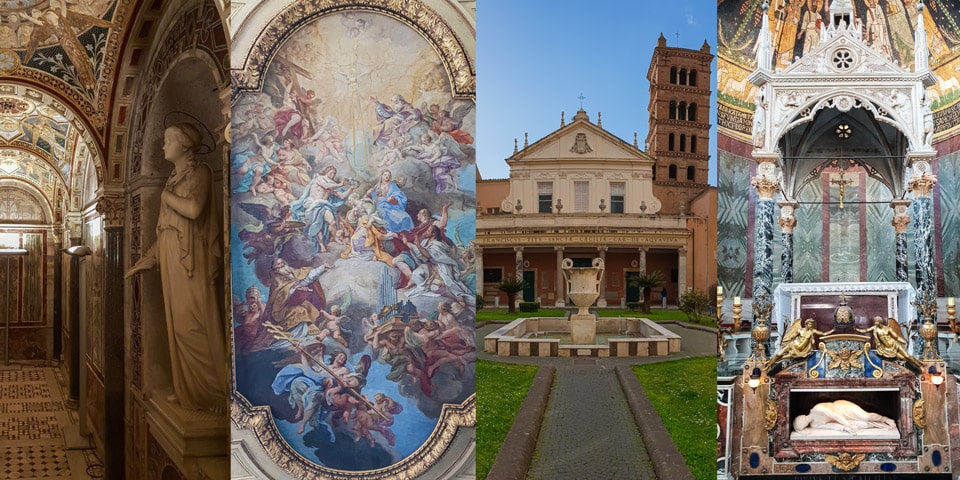
| Opening Hours |
Sunday:
- ,
-
Monday:
- ,
-
Tuesday:
- ,
-
Wednesday:
- ,
-
Thursday:
- ,
-
Friday:
- ,
-
Saturday:
- ,
-
|
|---|---|
| Closest bus stops |
|
| Closest subway stations |
|
| Address | Piazza di Santa Cecilia, 22, Roma |
| Website | www.benedettinesantacecilia.it |
The church and monastery of Saint Cecilia (Santa Cecilia) in Trastevere, Rome, were constructed over the home of St. Cecilia, martyred in the 3rd century. Her incorrupt body was discovered in 1599 with deep axe cuts in her neck. A statue under the Altar depicts her condition. Excavations beneath the church reveal Cecilia’s Roman house.
Contents
ToggleCecilia is one of the most famous Roman saints from the 3rd century, with her first legend recorded in the 6th century.
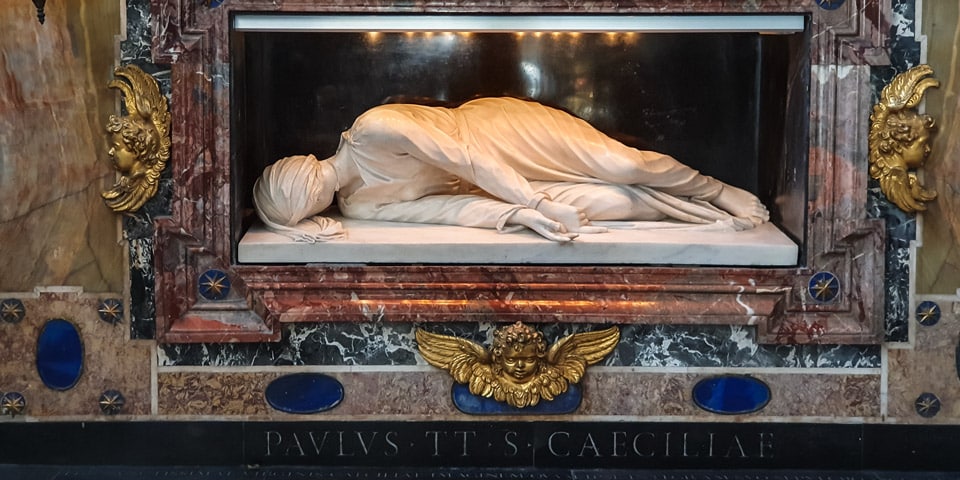
She took a personal oath of virginity and dedicated her life to God, even though her parents married her off. On her wedding night, she informed her husband, Valerian of Trastevere, about her vow and urged him to be baptized. Valerian, his brother Tiberius, and Maximus were baptized and eventually martyred for refusing to worship Roman gods.
According to legend, Cecilia was locked in the caldarium of her bathroom for several days but did not suffocate. During this ordeal, she sang as she was the patron saint of music. Later, a soldier was sent to behead her, but after three hacks with an axe, she remained alive. She died from her wounds three days later.
Read also about the Trastevere neighborhood.
St. Cecilia lived from 175 to 250 A.D. Legend says she was a patrician woman who owned a house in Trastevere and founded a church there. Archaeological excavations reveal that the house, dating to the 2nd century, was used for Christian worship by the 5th century. Cecilia was buried in the Catacomb of San Callisto near the Crypt of the Popes. The current church was built over the ruins of her house by Pope Paschal I (817-24). The bodies of Cecilia, Valerian, Maximus, and Tiberius were exhumed from their original burial sites and placed in the new church.
During early Christian times, it was common for rooms in a nobleman’s home to be made available for worship, thus naming the place of worship after the grantor.
During a renovation of the church in 1599, Cecilia was exhumed again and still found incorrupt, with three cuts in her neck.
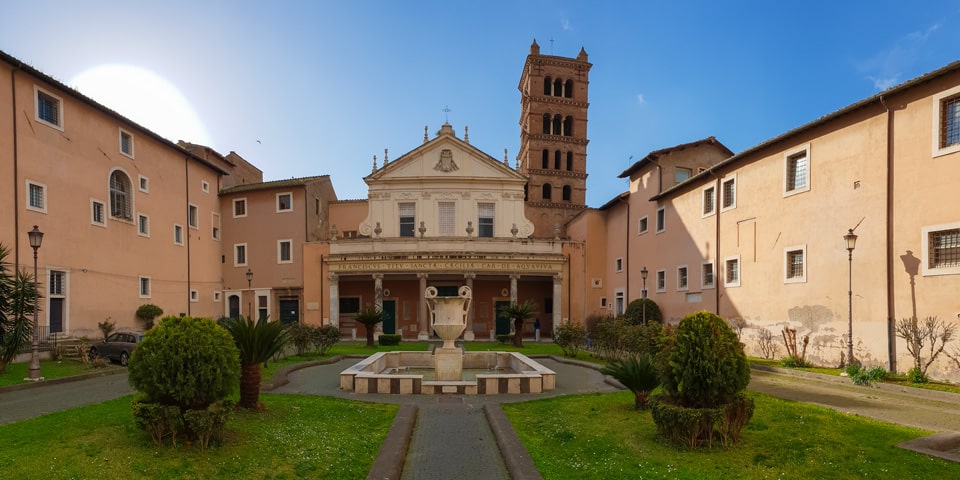
Santa Cecilia is a basilica with a brick interior. Ferdinando Fuga created the church’s façade in 1725, with additional renovations in 1823, including enclosing the columns inside piers. Another restoration occurred in 1990.
Passing through Fuga’s monumental façade, you enter an extensive rectangular courtyard dating back to Paschal I’s basilica. Fuga lowered the courtyard level to match the church interior. A fountain, dominated by a Roman “cantaro” from a wealthy home, was placed in 1929 in the center of what was likely originally an arcaded court.
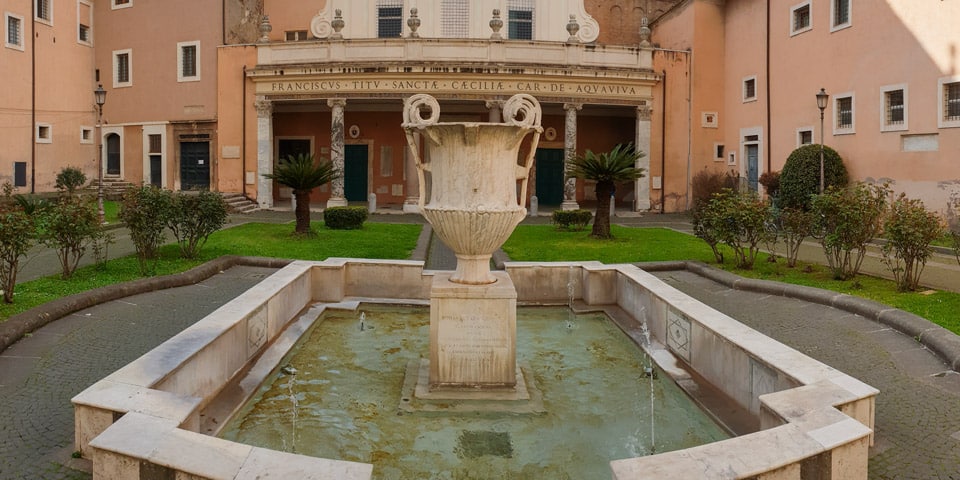
It had previously been in front of the church during the Middle Ages.
The wings of the two monasteries connect to the portico or “nartece” of the church, featuring four Ionic columns on Baroque pedestals and two lateral pilasters supporting the architrave.
The architrave decoration, dating to the 12th century, is a polychrome vitreous paste mosaic with racemes, corollas of many-colored flowers, and refined animal designs.
Some medallions portray titular saints, including St. Cecilia, St. Agatha, St. Tiburtius, St. Urban, and St. Lucius.
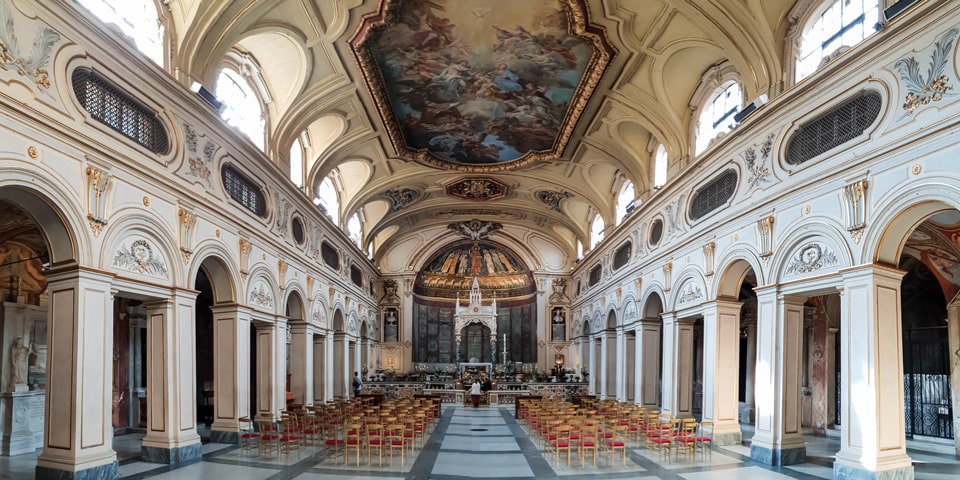
Famous artworks in the church include “The Last Judgement” by Pietro Cavallini (1293) and a Baldacchino by Arnolfo di Cambio over the Altar (late 1200s).
A moving sculpture by Stefano Mademo of Cecilia’s incorrupt body is in front of the choir.
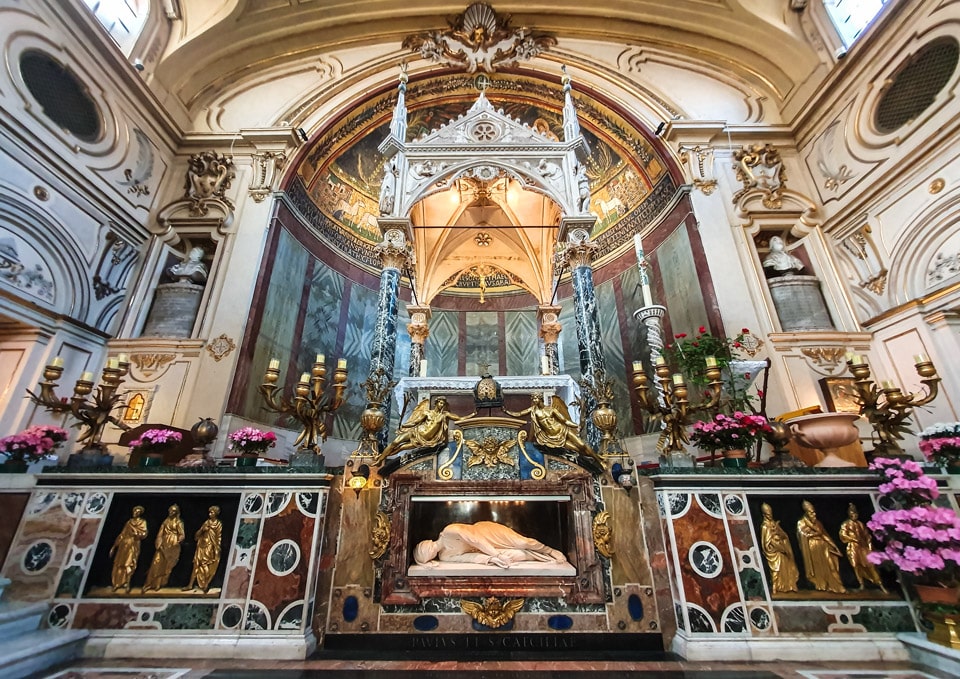
The apse above it is adorned with a 9th-century mosaic featuring seven standing figures: Christ in the center, surrounded by three saints, with a background of a meadow with flowers, sunset-lit clouds, and palm trees.
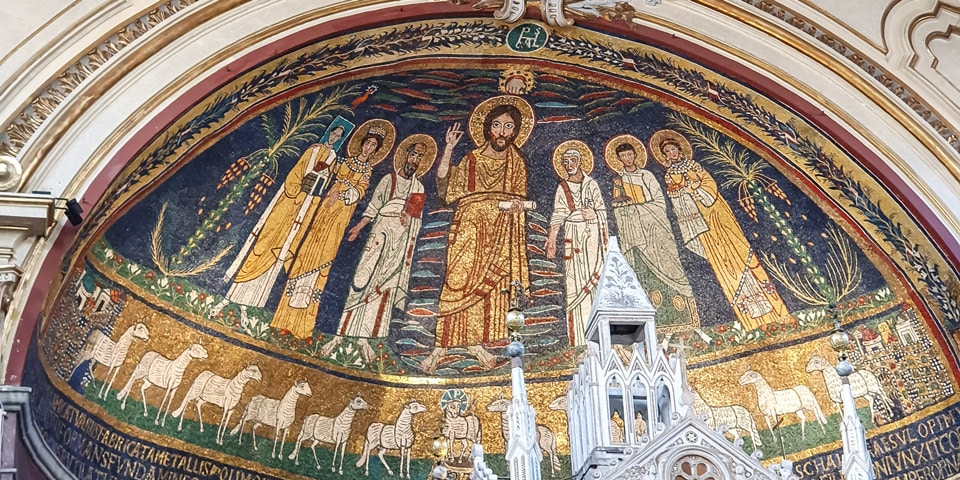
At the top of the triumphal arch is the monogram of Pope Paschal I, who built the church. Paschal is depicted on the left side of the mosaic, with a small phoenix above his head symbolizing resurrection. His reign was marked by devotion to Roman martyrs, transporting numerous relics from cemeteries outside the city to various churches in the town. The basilica Paschal I built shows similarities to S. Maria in Domnica and S. Prassede, built in the same period, though little of the original construction remains visible.
The 12 sheep in the mosaic represent the apostles, the Lamb of God, and the holy cities of Jerusalem and Bethlehem on either side.
The inscription at the bottom reads:
THIS SPACIOUS HOUSE GLITTERS BUILT OF VARIED ENAMELS;
THIS HALL, WHICH ONCE IN ANCIENT TIME HAD BEEN DEMOLISHED, THE GENEROUS PRELATE PASCHAL BUILT TO A BETTER STATE, SHAPING IT ON A FAMOUS FOUNDATION;
THESE GOLDEN MYSTERIES RESOUND WITH JEWELLED PRECINCTS;
SERENE IN THE LOVE OF GOD HE JOINED THE BODIES OF SAINT CECILIA AND HER COMPANIONS;
YOUTH GLOWS RED IN ITS BLOOM, LIMBS THAT RESTED BEFORE I CRYPTS: ROME IS JUBILANT, TRIUMPHANT ALWAYS, ADORNED FOREVER
The left aisle near the entrance contains the sacristy, serving as the entrance to the excavations beneath the church. Below are the ruins of two ancient Roman houses, mosaic pavements, Early Christian sarcophagi, and a small museum.
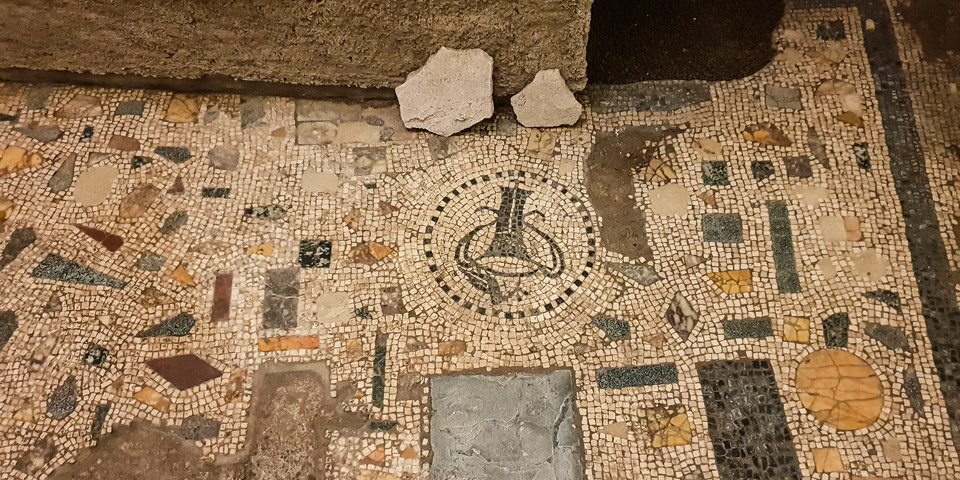
Eight cylindrical towers are believed to be part of a tannery, and a pagan household shrine with a relief of Minerva is also present.
On the right is the 12th-century medieval bell tower, the only leaning bell tower in Rome, made of cubes stacked on top of each other.
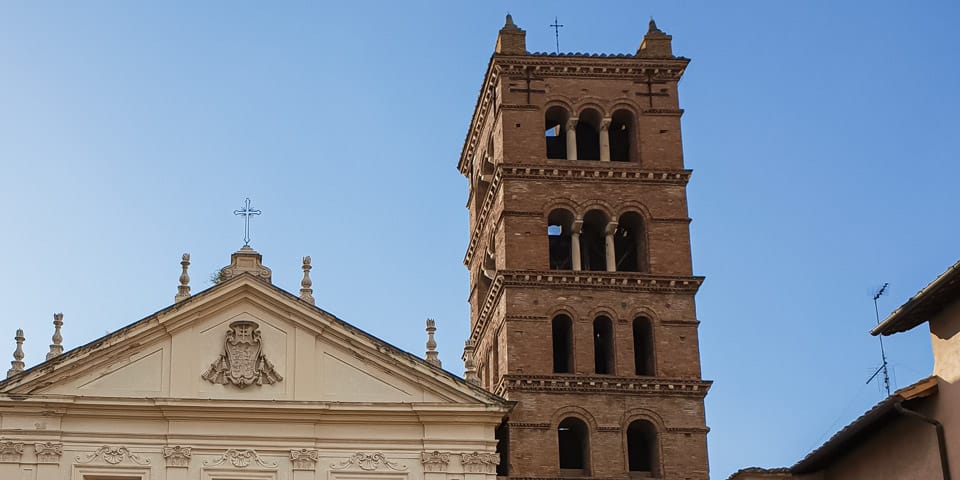
The two upper stories have windows with three lights, a model found in many Roman churches.
To the right of the entrance is the tomb of Cardinal Adam of Hartford (+1397), which has suffered changes and mutilations. Originally near the apse, it was moved under the portico and finally placed where it is today in 1595. Another titular of the basilica is Cardinal Forteguerri, whose monument was dismantled and reassembled in 1895, now appearing less homogeneous.
The marble busts of Popes Innocent XII and Clement XI are a result of an arrangement ordered in 1724-25 by Cardinal Francesco Acquaviva.
The excavations and crypt are reached from the end of the left nave. Entrance is paid. Before the stairs leading underground, two original columns of the basilica can be seen on the left wall. Remains of a Republican domus from the end of the 2nd century B.C. and an insula from the 2nd century A.D. were discovered beneath the basilica at a depth of 3 to 5 meters.
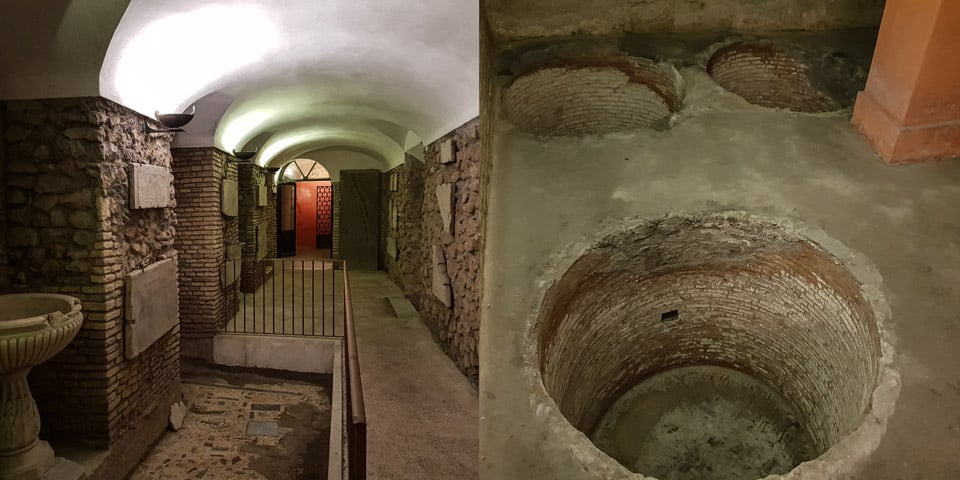
In the first half of the 2nd century A.D., during Trajan or Hadrian’s time, part of the Domus was absorbed into an insula due to the demographic expansion of Trastevere.
The modern aspect of the crypt is the result of an intervention by G.B. Giovenale, commissioned by Cardinal Mariano Rampolla del Tindaro at the beginning of the 20th century. The area was enlarged and became rectangular; the original floor was lowered by over a meter and decorated in polychrome marble. Also, twelve isolated columns and 18 against the walls support twenty vaults decorated with stuccoes with thrones and seraphs that hold the Cross.
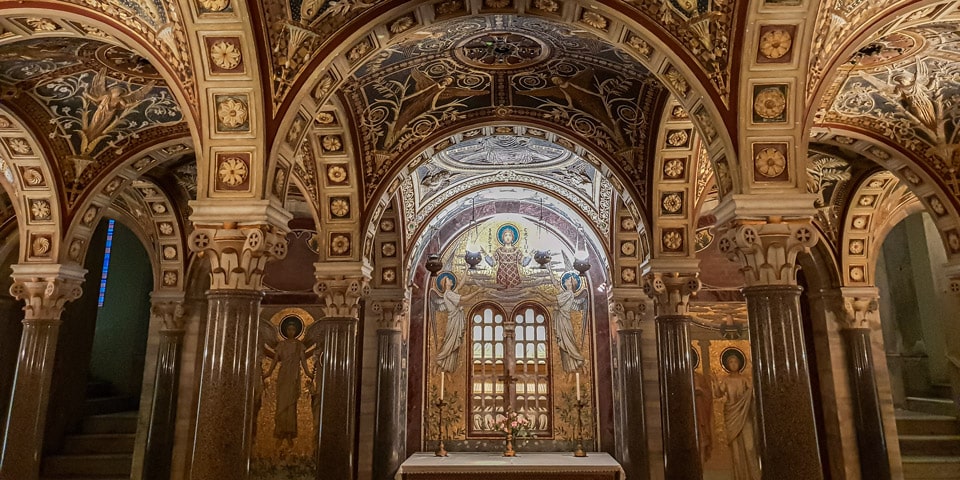
At the sides are two small chapels dedicated to St. Cecilia and St. Agnes.
Read also about St.Agnes Church in Navona Square.
The impressive story of St. Cecilia takes place in the 3rd century A.D. What is possible to know comes from the narration of her “Passio.” Undoubtedly, this is an exceptional type of literary genre that proposes a martyr as the emblem of the “imitation Christi” in humility and sacrifice. Also, according to scholars of Christian origins, this “Passio” is one of the most intricate tales of all the Roman hagiography. The basilica is one of the must-see sites in Rome.
Author: Kate Zusmann
This website uses cookies. For more info read the cookies policy
Rome.us © 2025. Created with love by Roman experts and guides.